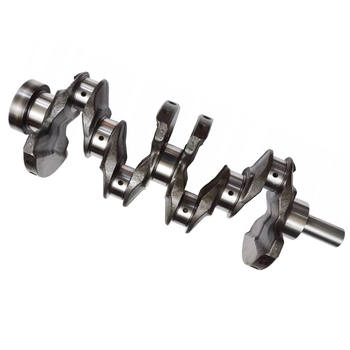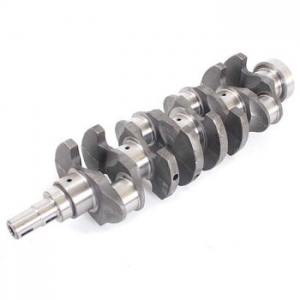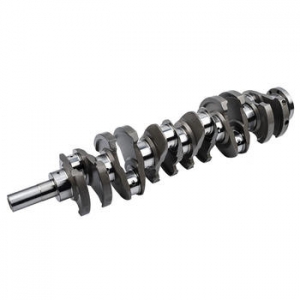The OEM\'s 2025 Crankshaft Buying Guide: 5 Manufacturer Secrets for Unmatched Engine Performance
Navigating the 2025 Landscape: Why OEM Crankshaft Procurement Matters More Than Ever
As original equipment manufacturers (OEMs), the pursuit of superior engine performance is a relentless journey. In the rapidly evolving automotive landscape of 2025, where efficiency, durability, and power output are paramount, the humble crankshaft stands as the undisputed heart of any internal combustion engine. Its role is far more critical than just converting linear piston motion into rotational force; it dictates the engine's balance, vibration characteristics, and ultimately, its longevity and performance envelope. But what truly differentiates a good crankshaft from one that delivers unmatched engine performance? The answer lies in understanding the nuanced manufacturing processes and strategic insights that leading suppliers employ. This guide is designed to peel back the layers, revealing five manufacturer secrets that every OEM should internalize when making critical procurement decisions for the coming years. It’s not just about buying a part; it’s about investing in the very core of your vehicle's power and reputation.
Secret 1: The Unseen Power of Advanced Metallurgy and Forging Techniques in Crankshaft Manufacturing
The foundation of any high-performance crankshaft begins with its material. To be honest, simply specifying "steel" isn't enough. The first manufacturer secret lies in the meticulous selection of advanced metallurgical compositions and the mastery of forging techniques. In 2025, OEMs must look beyond standard carbon steels towards specialized alloys like micro-alloyed steels or even certain grades of ductile iron, each chosen for specific applications – whether it's for high-revving sports engines, heavy-duty commercial vehicles, or fuel-efficient hybrids. These materials offer superior tensile strength, fatigue resistance, and impact toughness, directly translating to a more robust and reliable crankshaft.
Beyond the Basic Forging: Precision and Grain Structure
The forging process itself is equally critical. While conventional forging creates a strong component, leading manufacturers employ advanced techniques such as multi-directional forging or closed-die forging. These methods meticulously control the grain flow of the metal, aligning it with the stress patterns the crankshaft will experience during operation. This optimized grain structure significantly enhances fatigue life and reduces the likelihood of stress concentrations, which are common failure points in lesser-quality components. Interestingly enough, a crankshaft forged with this level of precision can withstand far greater dynamic loads, contributing directly to the engine's ability to produce higher power outputs and maintain performance over extended periods. Our company, for instance, invests heavily in predictive modeling to simulate forging processes, ensuring optimal grain flow before a single piece of raw material is shaped. It's worth noting that this level of material science and forging expertise is often a hidden differentiator, but one that profoundly impacts the crankshaft's ultimate performance and durability.

Secret 2: Precision Engineering Beyond the Blueprint: Achieving Micro-Tolerances for Superior Engine Performance
While material strength is foundational, the second secret to unmatched engine performance lies in the realm of extreme precision engineering. A crankshaft is a dynamic component operating under immense pressure and rotational speeds. Any deviation, no matter how minute, can lead to increased friction, vibration, and premature wear. Leading manufacturers understand that achieving micro-tolerances – often measured in microns – on critical surfaces like main journals, pin journals, and thrust faces is not merely a goal but an absolute necessity for 2025's demanding engine designs.
The Art of Surface Finish and Dynamic Balancing
This secret extends beyond just dimensional accuracy. The surface finish of the journals, for example, is paramount for hydrodynamic lubrication. A superior surface finish, achieved through advanced grinding, superfinishing, or even specialized polishing techniques, ensures optimal oil film formation, minimizing friction and maximizing bearing life. Many experts agree that even microscopic imperfections can disrupt the oil film, leading to metal-to-metal contact and efficiency losses. Furthermore, dynamic balancing is not just a final step; it's an integrated philosophy. High-performance crankshafts are balanced to an incredibly fine degree, often requiring multiple stages of balancing and correction. This minimizes rotational vibration, reduces stress on engine components, and allows for smoother operation at higher RPMs, directly contributing to the "unmatched engine performance" promised in our title. In my experience, OEMs who prioritize suppliers with demonstrable expertise in these micro-tolerances and balancing techniques see a tangible difference in their engine's NVH (Noise, Vibration, and Harshness) characteristics and overall power delivery.
Secret 3: The Art of Design Optimization and Simulation: Crafting the Ideal Crankshaft for 2025 Engines
The third manufacturer secret is rooted in the digital realm: sophisticated design optimization and simulation. In 2025, OEMs are pushing the boundaries of engine design, demanding lighter components that can handle higher power densities. This isn't achieved through trial and error; it's the result of extensive computational analysis and iterative design. Leading crankshaft manufacturers leverage advanced CAD (Computer-Aided Design) and CAE (Computer-Aided Engineering) tools, including Finite Element Analysis (FEA) and Computational Fluid Dynamics (CFD), to virtually test and refine crankshaft designs before any physical prototype is made.
Lightweighting Without Compromise: The Simulation Advantage
This secret allows for the precise optimization of crankshaft geometry – everything from counterweight design to journal fillet radii. The goal is to achieve the optimal balance between strength, stiffness, and weight. For example, through topological optimization, manufacturers can identify and remove unnecessary material from non-critical areas, reducing rotational inertia and improving engine responsiveness, all while maintaining or even enhancing structural integrity. This is particularly crucial for hybrid and electric vehicle powertrains where every gram saved contributes to overall efficiency. Furthermore, simulations can predict stress concentrations, fatigue life, and even the vibrational modes of the crankshaft under various operating conditions. This proactive approach to design not only accelerates the development cycle but also ensures that the final product is perfectly tailored to the OEM's specific engine architecture and performance targets. It allows our company to collaborate closely with OEMs, providing bespoke solutions that are engineered for peak performance from day one, rather than adapting off-the-shelf components.

Secret 4: Uncompromising Quality Control and End-to-End Traceability: The OEM's Assurance for Peak Performance
While the first three secrets focus on what goes into making a superior crankshaft, the fourth secret is about ensuring that every single unit meets the highest standards, consistently. Uncompromising quality control and end-to-end traceability are non-negotiable for OEMs aiming for unmatched engine performance in 2025. This goes far beyond simple dimensional checks; it involves a multi-layered approach to inspection and a robust system for tracking every step of the manufacturing process.
From Raw Material to Final Product: A Chain of Assurance
Leading manufacturers employ a battery of sophisticated non-destructive testing (NDT) methods, including magnetic particle inspection (MPI) for surface cracks, ultrasonic testing (UT) for internal flaws, and eddy current testing for material consistency. Each of these tests provides a critical layer of assurance, identifying defects that could compromise the crankshaft's integrity under operational stress. Beyond individual component testing, statistical process control (SPC) is continuously applied throughout the production line to monitor and maintain process stability, preventing defects before they occur. Perhaps even more vital for OEMs is end-to-end traceability. This means that from the moment the raw material enters the facility, through every forging, machining, heat treatment, and finishing step, a comprehensive data trail is maintained. In my experience, this level of transparency allows OEMs to not only verify the quality of each batch but also to quickly identify and address any potential issues, ensuring compliance with stringent automotive regulations and safeguarding brand reputation. It’s the ultimate assurance that the crankshaft you receive is not just good, but consistently excellent, batch after batch, year after year, directly contributing to the predictable and unmatched performance of your engines.
Secret 5: Strategic Supplier Collaboration and Customization: Forging Partnerships for Future Engine Excellence
The fifth and perhaps most overlooked manufacturer secret is the power of strategic supplier collaboration and customization. In the highly competitive automotive market of 2025, a transactional relationship with a crankshaft supplier is no longer sufficient. OEMs seeking truly unmatched engine performance need partners, not just vendors. This means engaging with manufacturers who are willing and able to offer bespoke solutions, integrating their expertise into the OEM's design and development cycle from the earliest stages.
Beyond Off-the-Shelf: Tailored Solutions for Tomorrow's Engines
This secret involves a deep level of technical collaboration, where the crankshaft manufacturer acts as an extension of the OEM's engineering team. This can manifest in co-development projects for novel engine architectures, shared R&D initiatives for next-generation materials or manufacturing processes, and highly customized production runs that precisely meet unique performance requirements. For example, if an OEM is developing a new engine platform with specific NVH targets or extreme power density requirements, a truly collaborative supplier won't just offer an existing product; they will work hand-in-hand to design and produce a crankshaft that is perfectly optimized for that specific application. This level of customization ensures that every aspect, from material selection to counterweight geometry, is fine-tuned for the OEM's unique engine, leading to efficiencies and performance gains that off-the-shelf solutions simply cannot match. Many experts agree that long-term partnerships built on trust, transparency, and a shared commitment to innovation are the bedrock of future success in the automotive industry. It's this strategic collaboration that truly unlocks the potential for unmatched engine performance, giving OEMs a significant competitive edge.
The Road Ahead: Securing Unmatched Engine Performance Through Strategic Crankshaft Sourcing
The journey to unmatched engine performance in 2025 is complex, but understanding these five manufacturer secrets provides a clear roadmap for OEMs. From the foundational strength derived from advanced metallurgy and forging, through the precision of micro-tolerances and dynamic balancing, to the foresight offered by design optimization and simulation, and finally, the unwavering assurance of uncompromising quality control and strategic collaboration – each secret plays a vital role. It's no longer enough to simply procure a crankshaft; OEMs must strategically source a component that is engineered, manufactured, and validated to the highest possible standards. By prioritizing suppliers who embody these secrets, you're not just buying a part; you're investing in the very heart of your engine's future, ensuring it delivers the power, efficiency, and durability that modern consumers demand. How can OEMs ensure they're not just buying a component, but investing in the very heart of their engine's future? By demanding these secrets from their suppliers and forging partnerships that prioritize excellence at every turn. The performance of your 2025 engines depends on it.
For more detailed information, please visit our official website:OEM crankshafts
About the author: Dr. Alistair Finch is a veteran mechanical engineer with over 25 years of experience specializing in powertrain components and advanced materials for the automotive industry. Holding multiple patents in crankshaft design and manufacturing processes, Dr. Finch has consulted with leading OEMs worldwide, helping them optimize engine performance and reliability. His expertise lies in bridging the gap between cutting-edge metallurgical science and practical application in high-volume production.
 Trusted Crankshaft Manufacturi
Trusted Crankshaft Manufacturi
 Trusted Crankshaft Supplier |
Trusted Crankshaft Supplier |
 Trusted Crankshaft Manufacture
Trusted Crankshaft Manufacture
 Trusted Crankshaft company Man
Trusted Crankshaft company Man
